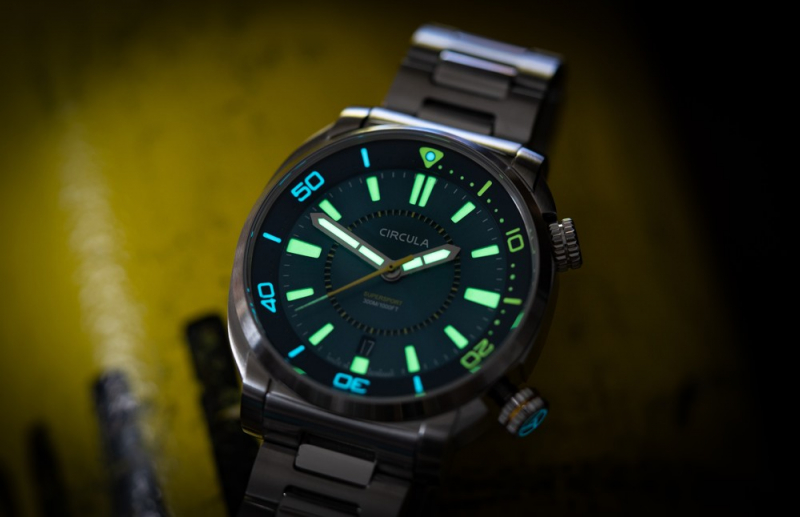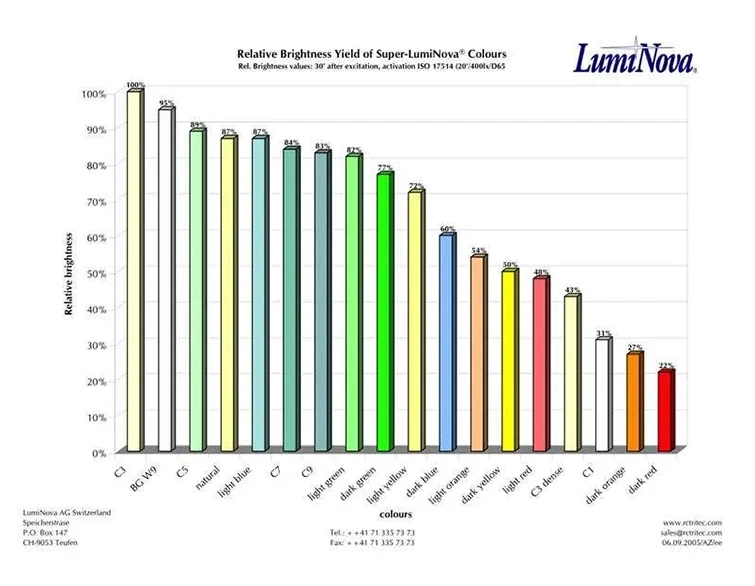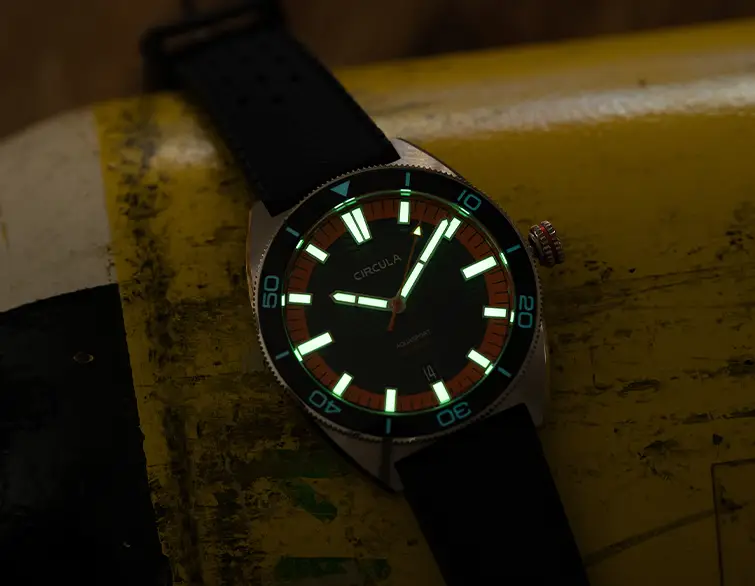Super-LumiNova®
and the watch glows!
What is Super-LumiNova®?
Super-LumiNova® are photoluminescent pigments (not photoluminescent pigments!) based on alkaline earth aluminate, which function in a similar way to small light storage batteries. When Super-LumiNova® is mentioned, it is usually Swiss Super-LumiNova® from the Swiss company RC TRITEC AG, which is manufactured 100% in Switzerland and is mainly used by the Swiss watch industry.
In order for the pigments to be applied to watches, they must be mixed with lacquer as a carrier layer. They can then be applied to the hands, indices and bezel using a stylograph, screen printing or transfer/pad printing.

Properties of Super-LumiNova®
Unlike its predecessors radium and tritium, Super-LumiNova® is not radioactive. It is also REACH-compatible (i.e. harmless to health), temperature-resistant and insensitive to environmental influences - provided it has been applied correctly.
Durability of Super-LumiNova®
The luminescent pigments can be charged with both daylight and artificial light (e.g. from a flashlight) and then continuously release the stored light energy, i.e. the afterglow becomes weaker and weaker until the pigments are fully charged, This means that the afterglow becomes weaker and weaker until the watch is recharged with daylight or artificial light. The recharging process itself can be repeated an infinite number of times, as Super-LumiNova® does not wear off and does not lose its luminosity over the years. In order to achieve a good result when applying the luminous pigments, various things must be taken into account, such as the correct mixing ratio of lacquer and pigments, the ambient temperature, the application thickness, the type of drying (baking or in the air), the application of a second coat or how the hands, indices or numerals were cleaned before the luminous material was applied.
Super-LumiNova® luminous duration
Depending on how intensively the luminous pigments are charged, they can glow for a few minutes or all night long. If the luminous markings have been applied in sufficient size and mass, then perfect readability throughout the night is guaranteed in accordance with ISO 3157. Incidentally, the thickness of the luminous material applied has no influence on the luminous duration - it is purely a visual design feature, as numerals and indices appear more three-dimensional when applied in several layers.
Super-LumiNova® Grade
The different grades refer to the luminosity and luminous duration. Super-LumiNova® is available in three different grades: Standard Grade Grade A Grade X1 The Standard Grade has the shortest glow time and X1 the longest. Grade X1 is easier to activate and is still 60 % brighter than Grade A after two hours.
The most common color variants
Super-LumiNova® C3
C3 is yellowish in daylight and glows green in the dark. With a relative luminosity of 100 %, C3 is the brightest Super-LumiNova®. We use C3 for the hands and indexes of the Circula AquaSport automatic. We also use C3 in the 2nd generation of the AquaSport, but in the highest quality level X1.
Super-LumiNova® BG W9
BG W9 is white in daylight and glows green-blue in the dark. The designation BGW is made up of the English color designations: blue green white. Compared to C3, BG W9 has a luminosity of 95 %.
Super-LumiNova® C1
C1 is white in daylight and glows green in the dark. With a luminosity of 31 % compared to C3, C1 is very discreet.
Super-LumiNova® Old Radium
Old Radium is light orange to brownish in daylight and glows green in the dark.

Despite the wide range of colors (blue, green, violet, white, yellow, orange, pink...), Super-LumiNova® in shades of green and blue are usually used for watches. The reason for this is that the human eye can best recognize green afterglow when entering a dark room from daylight. Once the eye has become accustomed to the darkness, blue afterglow is easier to recognize.
For the Circula AquaSport II, for example, we use Swiss Super-LumiNova® C3 X1 for the hands and indices, and BGW9 for the markings on the bezel. With the SuperSport, it's the other way around.

The forerunners of Super-LumiNova®
At the beginning of the 20th century and into the 1960s, radioactive substances based on radium were used to light up wristwatches. Although these radiated continuously and without having to be charged, the coating emitted (and still emits today due to its long half-life of 1622 years!) an unhealthy level of radioactive radiation.
At the end of the 1950s, weak radioactive isotopes such as tritium and promethium, which have a half-life of only 12.5 years and whose radiation cannot penetrate the metal cases and glasses of watches, were used instead of radium.
In 1973, the Japanese company Nemoto & Co. finally developed a long-lasting phosphorescent pigment based on radioactively activated zinc sulphides.
It was not until 1993 that Nemoto & Co. succeeded in developing the phosphorescent and completely non-radioactive pigment LumiNova®. In contrast to the phosphorescent pigments based on zinc sulphide, these pigments were ten times brighter and also glowed ten times longer. Within a few years, LumiNova replaced fluorescent paints that used radioactive materials.
In 1998, Nemoto joined forces with the Swiss company RC-Tritec to produce high-quality luminescent pigments, namely Swiss Super-LumiNova®, for the Swiss watch industry.
